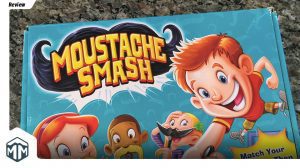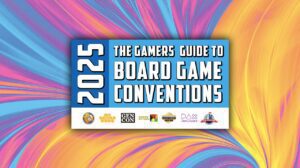Mythical Dice – Justin Bell
A few years ago, I played Skull King (a riff on the classic game Oh Hell!) for the first time. Pure chaos, a game that works better as a shorter game than a longer one…but, in a game that runs for 10 rounds, shorter is not really on the table. When one player indicated that they are “really good at Skull King”, I laughed; if Skull King is a game of skill, then I’m your brother’s uncle.
Mythical Dice, originally published in 2016 as Mino Dice and given a new coat of paint by IELLO and Playte for a 2025 re-release, is Skull King with dice. You’ve still got the First Mate, the Mermaids, the Skull King, and a bunch of number cards, all represented here by dice with unique faces based on the level of each character. Scoring is still the same, with tricks equal to the round number…so, in the first round, there’s only one trick to be had, and bidding nil scores points equal to the round number times 10. The Skull King here is a Minotaur, the First Mate is a Griffin and the Mermaid is…well, the Mermaids are still Mermaids. (I don’t get it, either.)
I’ll give Mythical Dice this much: I hate the Skull King system, but I much prefer to deliver that system with dice versus cards. Also, I do like the idea that even having the Minotaur doesn’t guarantee that you have the Minotaur, because two of the six Minotaur die faces show white flags, Skull King vernacular for blanks or zeroes. Mythical Dice is also a tad shorter than Skull King, with eight rounds in a 3-4 player game and less with higher player counts. So, while I have seen a game of Skull King last for an hour (a game that just happened the week before I drafted this review), Mythical Dice mostly avoid overstaying its welcome.
Ease of entry?
★★★★☆ – The odd bump or two
Would I play it again?
★★★☆☆ – Wouldn’t suggest it, but would happily play it
Read more articles from Justin Bell.
Knitting Circle – K. David Ladage
Andy Matthews, our esteemed leader over here at Meeple Mountain, wrote a wonderful review of Knitting Circle. As a fan of Calico, this was a game I jumped on when it was announced. Life got in the way of getting it to the table, so it took some time. But recently, we got it out and played a couple of games (three players each time, once with and once without the Advanced scoring options).
I have to say, Andy nailed it with his review. Our experience was very close to his. This is a game I would love to play with him and his family. We did have some issues with the components: the color on some of the yarn tiles varies oddly from tile to tile; the triangular buttons would make more sense if the triangle pointed downward and the number was rotated 30-degrees (or if the text were at the bottom of the triangle with the number at the upper point); the garment cards are a bear to shuffle; the player boards could have used the double-layer treatment used in Calico; and other exceedingly minor issues. Overall, it is a fine game that will find its way to our table again quite soon.
Inside the rules, however, is a gem of an alternative way to handle the drafting of pieces in Calico. Knitting Circle uses a very interesting rondel for gathering yarn, and the variant presented is to use the same rondel in Calico to draft the quitting pieces. This has me excited to try it very soon!
Ease of entry?
★★★★★ – No sweat
Would I play it again?
★★★★☆ – Would like to play it again
Read more articles from K. David Ladage.
Frozen Shinies: The Emperor Penguin’s Nephew – Kevin Brantley
Left Justified Studios has killer branding. Whether it’s leaning into their pickles, penguins, or lumberjacks, these recognizable mascots are found all over their catalog. Thematically, this game is a spinoff of Jewels for the Emperor Penguin, but features the Emperor’s charming nephew. The nephew doesn’t quite understand value yet—he thinks more stuff is better than less stuff (regardless of what that stuff is). To him, five sticks are worth more than one bar of gold. Cute.
This quick little game mixes hand management with some light math. The player with the most cards wins—simple as that. The puzzle comes in figuring out how to get more cards. Players can either play a card for its value (1 through 14) or for its power. When played for value, the player can take cards totaling up to that number—but cards must be collected in order from each column. Sometimes, the numbers just don’t math out.
Powers include taking from the front or back of a column, and even earning extra turns. Small wooden fish tokens can boost a card’s value or be cashed in for an extra turn if you have enough.
It’s a charming little filler that plays fast. Cards disappear quickly, and before 15 minutes are up, you’re already scoring. The artwork is cute, and I imagine it would click well with kids (though I couldn’t test that theory myself). The flow is simple but offers enough decision space to keep you watching your opponent’s card count.
It’s not going to make the biggest splash on game night, but the small box and quick playtime make it a handy little game for counting cards.
Ease of entry?:
★★★★★ – No sweat
Would I play it again?:
★★★☆☆ – Wouldn’t suggest it, but would happily play it
Read more articles from Kevin Brantley.
Bare Bones – Andy Matthews
Often when you play a game from an unknown publisher, the results can be…less than stellar. When I received a review request for Bare Bones from West Coast Bias Games I was a bit skeptical. But after I read through the rules, I realized that here was a game which seemed custom made for me. Part dice game, and part deck / engine builder, this was a game that I would likely enjoy. And while it didn’t knock my socks off, I quite enjoyed my first play and I’m looking forward to another.
In Bare Bones, players build a deck from two types of cards: dice cards and action cards. The dice cards provide either points that you can earn each round, or money which can be used to purchase additional cards. The action cards give you special abilities that can affect the quantity of dice you roll, or their resulting values. Players start with a matching deck of cards and then, in standard deck-building fashion, draw cards each round and do what the cards say.
The setup includes all of the dice cards, each of which have different faces that make them more valuable (but also more expensive). And similar to Dominion, players choose only 7 decks of action cards, from the much larger available pool of 20. The game even provides a “randomizer” deck to make it easier for players to seed the action card pool during setup. Even though it’s heavily luck dependent because of the dice rolling, the design team did a great job of mitigating that luck by enabling tactical decisions about card purchases and enabling killer combos that can wow the entire table–like as when my son rolled 3 black dice (which have mostly sixes on their faces) and then played the Color Cubed card which allowed him to double the value of all three of those dice; earning him a cool 42 points in one turn. Luck-based or not, Bare Bones certainly isn’t boring!
Ease of entry?
★★★★☆ – The odd bump or two
Would I play it again?
★★★★☆ – Would like to play it again
Read more articles from Andy Matthews.
Révolte – Andrew Lynch
There was a brief moment during the first hand of Révolte, a trick-taking game, when I wondered if it might be brilliant. It has moderately—but not unpleasantly—baroque rules: If you can, you have to follow, play a grey card, or play a blue card with money (which renders it a trump card). If you can’t do any of those, you can play whatever you want, potentially reaping the benefits of whichever suit you play. The highest purple gains a point. The lowest orange gains money. More citizens than any other suit nullifies the entire trick.
For that first hand, I wondered how the experience would change from deal to deal. Would a hand full of purple cards feel distinct from a hand full of yellow? How often would grey cards reach critical mass? What would the politics of the game, given the relative freedom afforded players, be like?
In the end, it all fell flat. All trick-takers have good hands and bad hands, but Révolte has good hands and horrendous hands, the latter outnumbering the former by a wide margin. Most rounds, you have nothing to do. A handful of grey cards means they haven’t been distributed in sufficient numbers for them to do anything. You’re just along for the ride. Blue cards are useless unless you’ve previously lucked into the low orange cards necessary to get money. A handful of purples is just about the only good hand you can get, and even that isn’t interesting so much as it’s productive.
Ease of entry?
★★★★☆ – The odd bump or two
Would I play it again?
★☆☆☆☆ – Would play again but will cry about it
Read more articles from Andrew Lynch.












